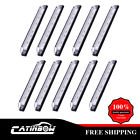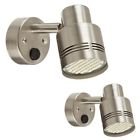boomerang
Guru
- Joined
- Apr 29, 2016
- Messages
- 1,398
- Location
- united states
- Vessel Name
- Wandering Star
- Vessel Make
- PSN40
So most of the lights on our boat have been replaced with LED bulbs and we've also added several complete LED fixtures. The anchor light bayonet bulb and running lights festoon bulbs were replaced with higher-end Lunasea LED's. I added a couple of Innovative light bars over the seating in the salon for reading & the overhead light in the head was replaced with a Lunasea touch-dimming fixture. They've all been flawless and cool to the touch like I assumed LED's are supposed to be. Here's where my decision to replace the other non-critical lights with cheap Chinese Ebay lights has me wondering if I didn't just throw the money overboard or worse yet, put us in jeopardy. I bought a bundle of bar lights for the engine room & area under the cockpit & haven't noticed that they get super hot & am very happy with the output, So far. The additional reading lights in the salon use the MR11 LED bulbs and do get kind of warm but not hot enough to concern me. The bad ones are the 1156 bulb replacement LED's. I had them on in the stateroom the other day & noticed smoke coming from both of them. I thought something might've splashed on them but when I removed the bulbs, several of the individual LES's had gotten so hot that they self destructed. There's no telling what would've happened had I left the lights on & I wasn't there.
Anyway, my point is I think it wise to spend the extra $$ on quality lights and leave the cheap stuff alone.
Anyway, my point is I think it wise to spend the extra $$ on quality lights and leave the cheap stuff alone.





